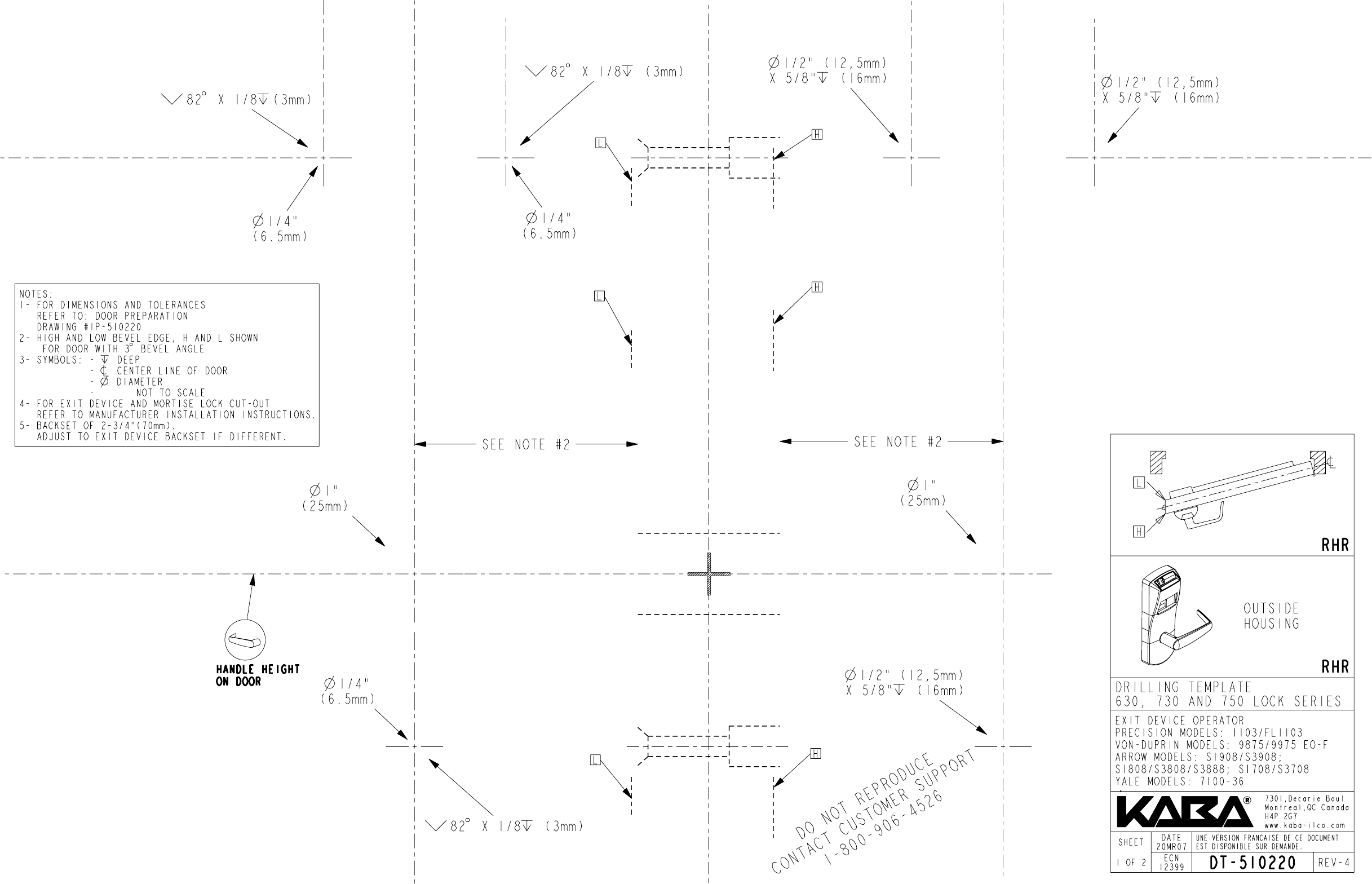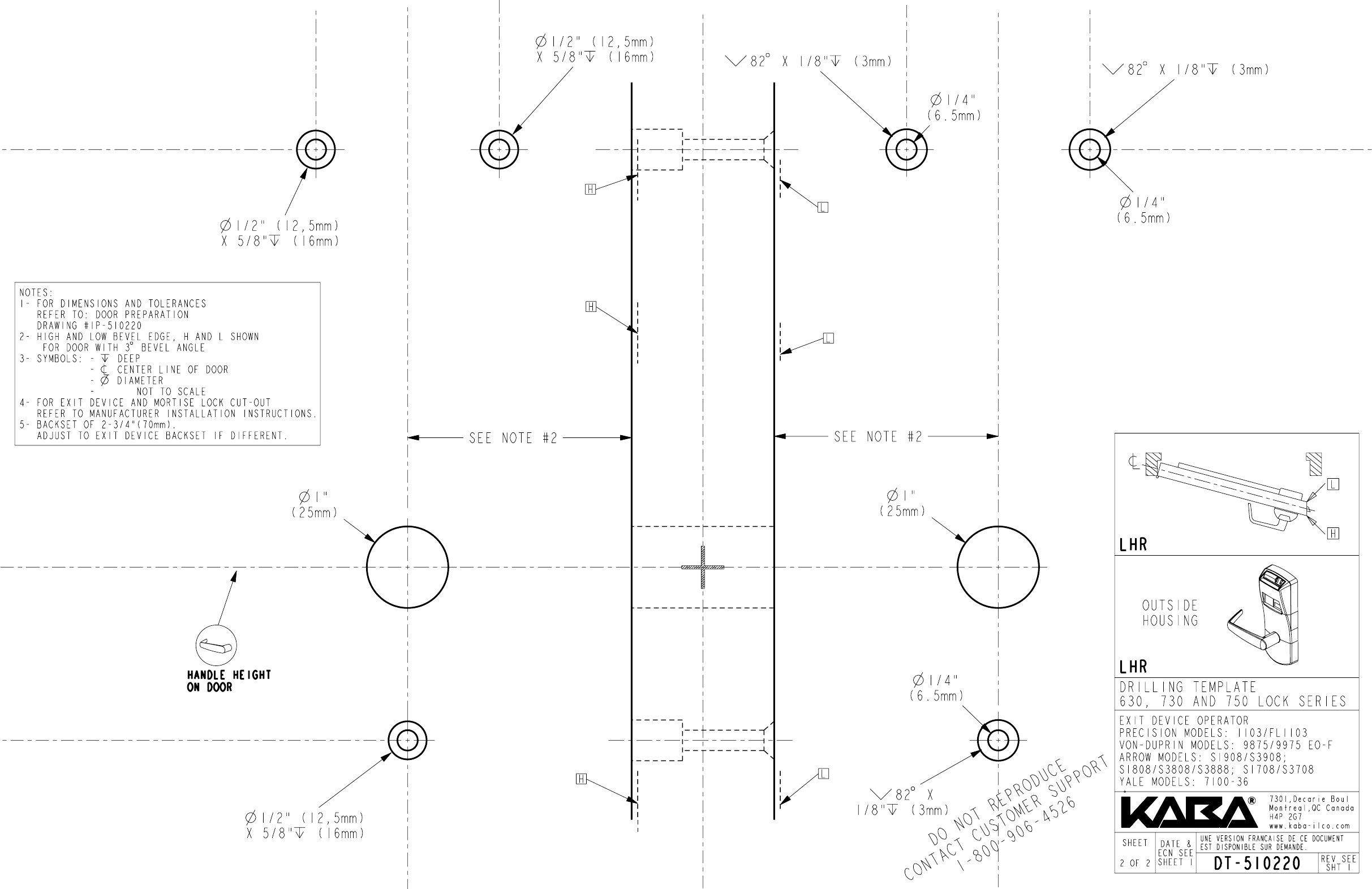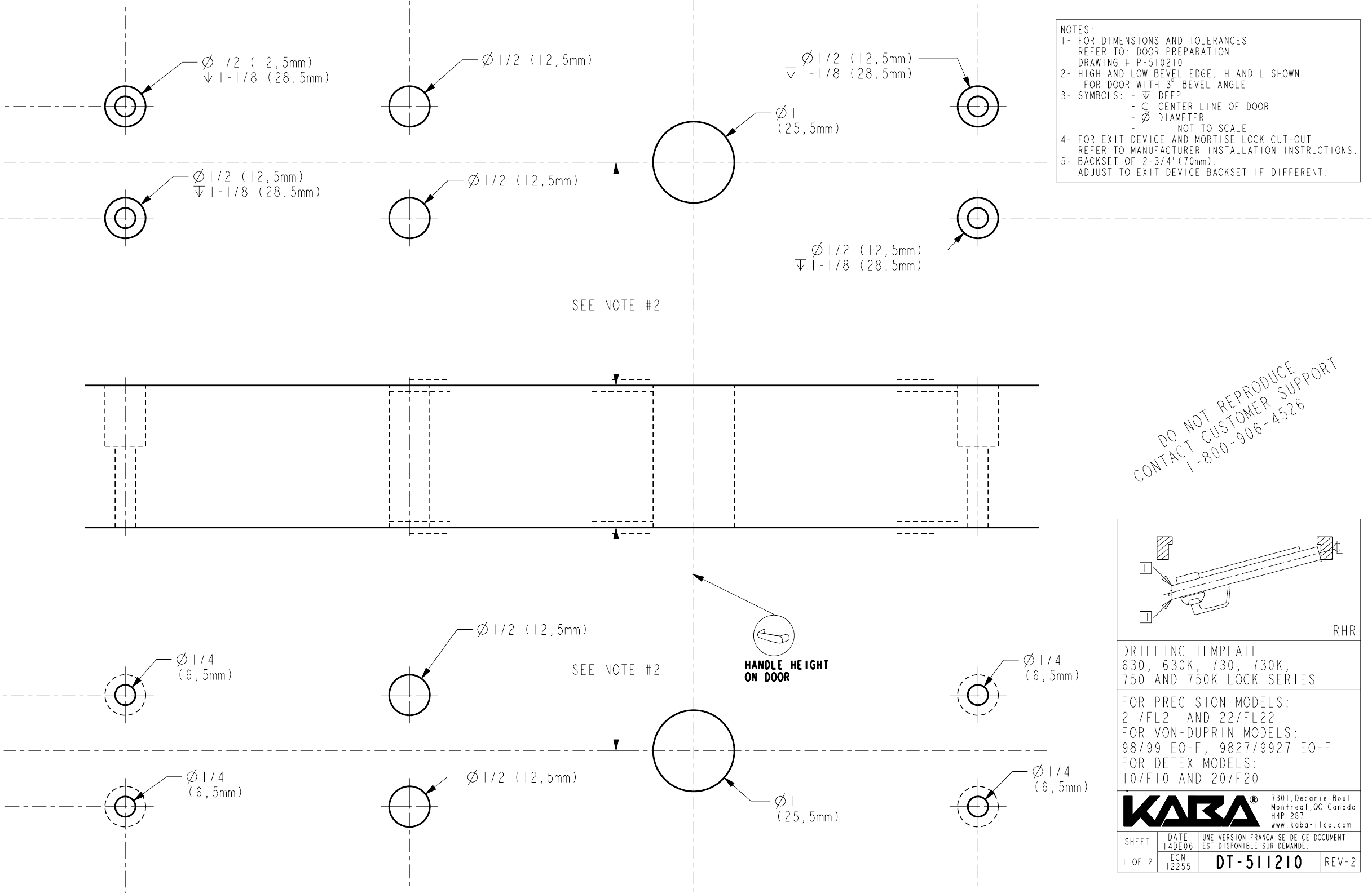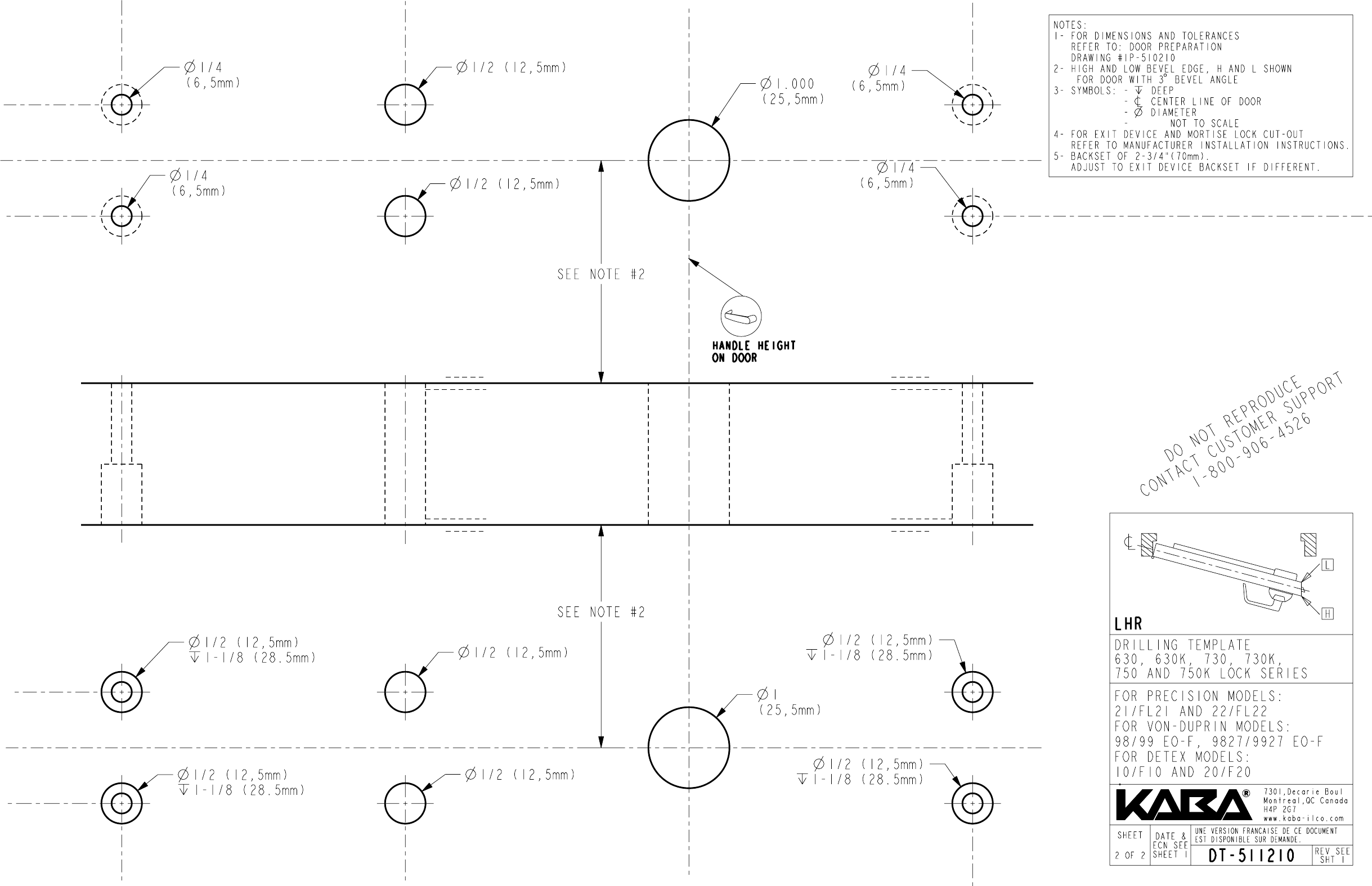dormakaba Canada CSC790 Door Lock User Manual Manual
Kaba Ilco Inc. Door Lock Manual
Manual

PK2925-T _11_07 Printed in Canada
KabaIlco Inc.
7301 Boul. Décarie Montréal (QC) H4P 2G7
Technical Support:
1.800.906.4526
Customer Service:
T: 1.877.468.3555
F: 514.735.6589
General Information:
www.kabailco.com
Online Consumable Orders:
www.keycard.com
To access all of our easy steps,please visit our Support Website:
http://connect.kabalodging.com
INSTALLATION GUIDE
Exit Device Operators - Generation E-730 / 630 / 750 / 79E Series
PK2925-T_11_07
E-730 Series 630 Series 750 Series 79E Series

E-730/630/750/79E SERIES INSTALLATION GUIDE • PK2925-T_11_07
Page 18
Note for Contactless 790 customers:
Statement according to FCC part 15.105
This equipment has been tested and found to comply with
the limits for a Class B digital device, pursuant to Part
15 of the FCC Rules. These limits are designed to provide
reasonable protection against harmful interference in a
residential installation. This equipment generates, uses,
and can radiate radio frequency energy and, if not installed
and used in accordance with the instructions, may cause
harmful interference to radio communications. However,
there is no guarantee that interference will not occur in a
particular installation. If this equipment does cause harmful
interference to radio or television reception, which can be
determined by turning the equipment off and on, the user
is encouraged to try to correct the interference by one or
more of the following measures:
receiver.
for help.
Statement according to FCC part 15.21
void the user’s authority to operate the equipment.
Statement according to FCC part 15.19
This device complies with Part 15 of the FCC Rules.
Operation is subject to the following two conditions:
(1) this device may not cause harmful interference, and
(2) this device must accept any interference received,
including interference that may cause undesired operation.
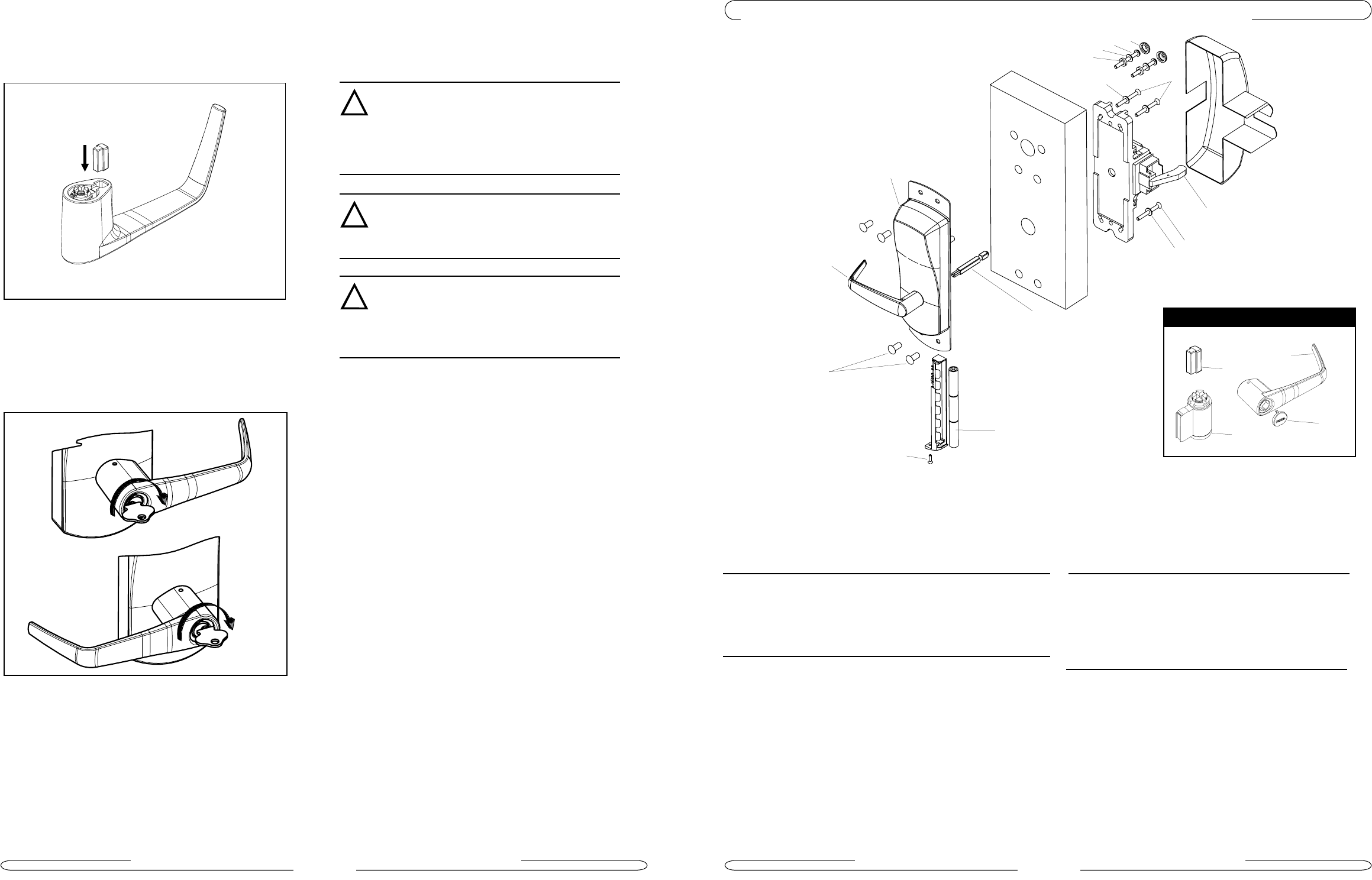
E-730/630/750/79E SERIES INSTALLATION GUIDE • PK2925-T_11_07
Page 17
31. Re-insert the cylinder plug (Fig. 19)
32. While holding the cylinder and plug in place, insert the key
33. Turn the key approximately 100º clockwise
34. Repeat the steps 1 to 9 to attach the lever handle to the lock
housing. (see Fig. 20)
!
the latch or deadbolt. Do not use too much force
when turning the key as this may damage the unit.
To retract the latch, turn the key clockwise until it
stops, release the key and turn the lever handle (H).
See page 15
!
Important: Always keep the door open while install-
ing and verifying the functionality of the
override. Do not close the door until you are certain
that you have installed the unit correctly.
!
Note: The lever handle must stay in the horizontal
position when turning the key (do not try to turn
the key while turning the handle) or the override
mechanism will not work.
Fig. 20
Fig. 19
Right-handed lock
Left-handed lock
HOW TO CHANGE LOCK CYLINDERS (continued)
Mechanical Override Models ONLY
I CHECKLIST FOR PRECISION EXIT DEVICES 21/22/FL21/FL22
VON DUPRIN 98/99EO-F/9827/9927 EO-F
** DETEX 10/F10/20/F20
E-730/630/750/79E SERIES INSTALLATION GUIDE • PK2925-T_11_07
Page 2
Each Generation E-730/630/750/79E lockset includes:
(A) Outside lever handle
(B) Outside housing/ Gasket /Adapter plate
(C) Battery holder with 3 AA batteries
(D) Exit Device (Included if ordered with lock operator)
Parts inside hardware bag:
(E) 4 x Mounting Plate Bushing
(F) 2 x Snap Screw Retainer Cup
(G) 2 x Washer No.8
(H) 2 x Snap Screw Cap
(I ) 1 x Spanner-head Screw
(J) 2 x Mounting Screw (10-24 1/8” Hex)
(W) 4 x Flat Washer 1/2 OD X 7/32 ID for Detex Exit Device Only
K/L/M Available for Thin and Thick Doors
(K) 2 x Spindle for Precision, Von Duprin and 1 spindle for Detex
(L) 2 x Mounting screw (10-24 1/8” Hex)
(M ) 2 x Mounting Screw (10-24 Pan head Philips)
Tools Required:
Safety glasses
1
/4” (6.5mm) drill bit
1
/2” (13mm) drill bit
1” (25mm) drill bit or hole saw
Drill
Awl or center punch
Hammer
Rubber mallet
Small flat screwdriver
Philips #2 screwdriver
Spanner screwdriver (No 6)
1
/8” Allen key
Adjustable square
Tape measure
Pencil
Tape
Cleaning supplies
(drop cloth, vacuum)
©2005 Kaba Ilco, Inc. All trademarks and registered trademarks are the property of their respective owners.
A
E
I
B
J
F
H
M
K
D
L
Q
C
Mechanical Override Models ONLY:
(N) Outside Lever Handle
(O) Cylinder Plug
(P) Cylinder (for 630 series lock with cylinders keyed
different ONLY)
(Q) Cylinder Cap
P
O
N
G
** Detex 10 & 20 Series are Panic Hardware only. (Not fire rated)
Detex F10 & F20 Series are Fire Exit Hardware (Fire Rated)
W
W
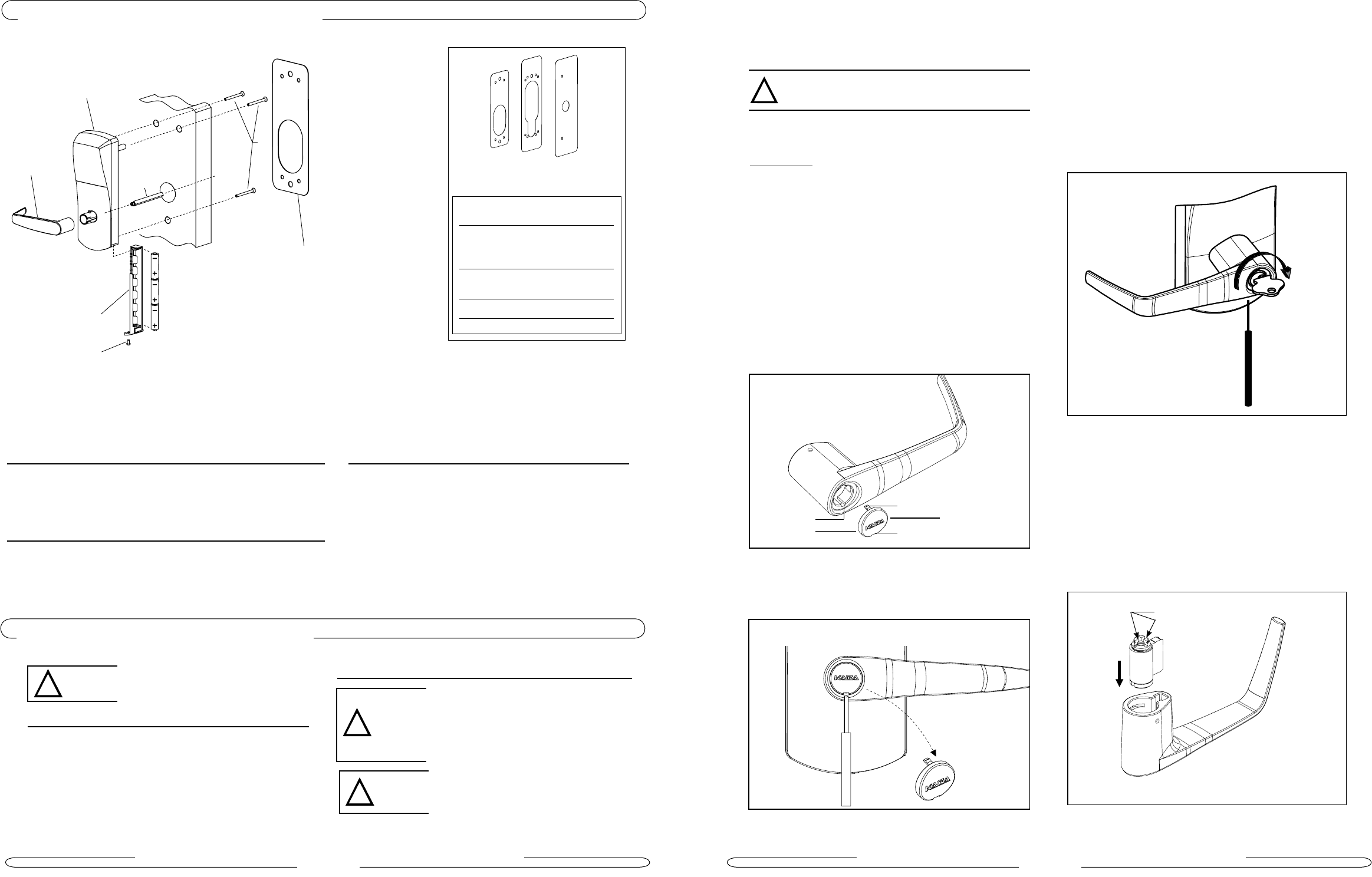
E-730/630/750/79E SERIES INSTALLATION GUIDE • PK2925-T_11_07
Page 3
Target Audience
Please read and follow all directions carefully. These
instructions are designed for use by maintenance profes-
sionals or lock installers who are familiar with common
safety practices and competent to perform the steps
described. Kaba Ilco is not responsible for damage or
malfunction due to incorrect installation, that may arise.
II INTRODUCTION AND DISCLAIMERS
Please read and follow all directions carefully.
!
Important: Carefully inspect windows, doorframe, door, etc.
to ensure that the recommended procedures will not cause
caused by installation.
!
Caution: Wear safety glasses when making the holes.
!
I CHECKLIST FOR STANDARD EXIT DEVICES
Each Generation E-730/630/750/79E lockset includes:
(A) Ouside lever handle
(B) Outside housing
(C) Battery holder with 3 AA batteries
(D) Inside dress plate
Parts inside hardware bag:
(K) 1 x Spindle
(I) 1 x Torx-head screw
(J) 3 x mounting screws (10-24, 1
/8” hex head)
Tools Required:
Safety glasses
1
/4” (6.5mm) drill bit
1
/2” (13mm) drill bit
1” (25mm) drill bit or hole saw
Drill
Awl or center punch
Hammer
Rubber mallet
Small flat screwdriver
Torx screwdriver (T-15)
1
/8” Allen key
Adjustable square
Tape measure
Pencil
Tape
Cleaning supplies
(drop cloth, vacuum)
221 222 223
Inside Dress Plates
D
Part # Manufactured By
061-510221 Arrow S3808/S1808
S1908/S3908
S1708/S3708
061-510222 Von Duprin 9875/9975 EO-F,
Precision 1103/ FL1103
061-510223 Yale 7100-36
Warnings and Conditions
B
A
C
I
K
J
D
E-730/630/750/79E SERIES INSTALLATION GUIDE • PK2925-T_11_07
Page 16
22. The cap has a small groove on one edge (to allow ease of removal)
this should be facing down. Insert bottom snap of cap (I, see page 11) in
handle hole below the cylinder. With a small screwdriver, push top snap of
cap down while pushing the cap into place to cover the keyhole (Fig. 15)
23. To remove the cap, insert a small flat screwdriver into this groove and
gently pry the cap off, being careful not to damage it. (You may want
to cover the bottom of the lever to protect the
finish from being scratched
through the process of removing the cap). (Fig.16)
19. With the door open, insert key in cylinder and turn it clockwise
until it stops.
20. Let go of the key and turn the lever handle (clockwise for
right-handed and counter-clockwise for left-handed locks). The latch
must retract.
21. Extend deadbolt and repeat the above operation (turn key clockwise
until it stops), latch and deadbolt must retract completely.
Test the Mechanical Override Function (continued)
!
lock is installed on the door:
Fig. 16
COVER THE KEYHOLE & CYLINDER WITH THE CAP
9.
HOW TO CHANGE LOCK CYLINDERS
10.
Fig. 17
24. Remove the cap from the lever handle (see step 20, Fig. 16).
25. Insert key.
26. Turn the key clockwise until it stops.
27. Release key.
28. Use a small flat screwdriver to push in the lever catch through
the small hole underneath the lever handle (Fig. 17).
29. Pull the lever handle off of the lock housing (be careful not to
lose the cylinder plug).
30. Replace the old cylinder with the new one in the lever handle. Only
same kind of cylinder with 2 grooves in cross, in the end of the cylinder plug
could be used on the E-730/630 Series locks. (Fig. 18)
Fig. 18 2 Grooves in cross
Fig. 15
(I)
Hole below cylinder
Bottom snap (First)
Top snap (Second)
Push (Third)
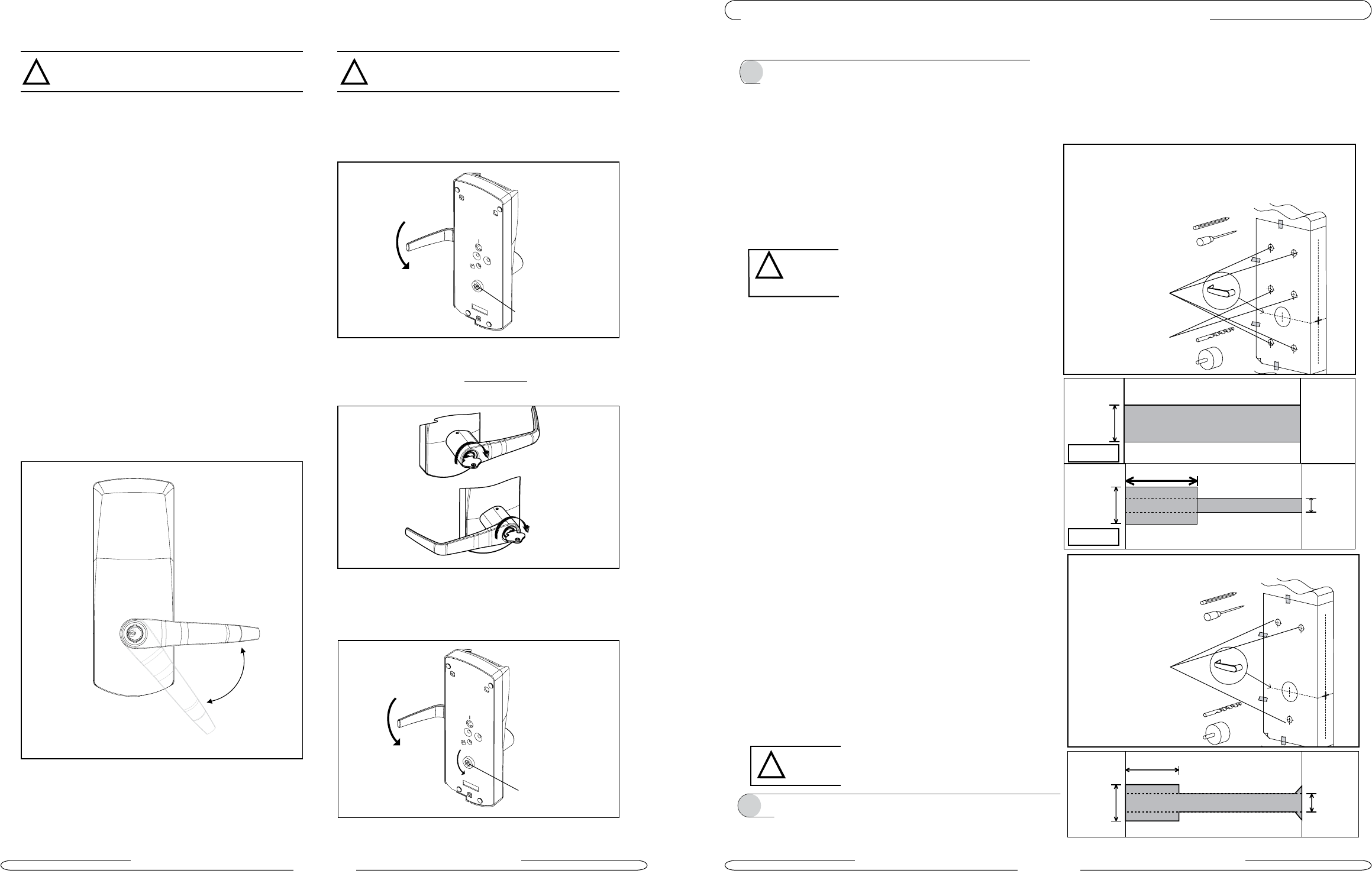
E-730/630/750/79E SERIES INSTALLATION GUIDE • PK2925-T_11_07
Page 15
13. Turn the handle clockwise (for a right-handed lock) or counter-clock-
wise (for a left-handed lock)
14. Release the handle slowly. It should return freely to its horizontal
position. (Fig.11)
15. If the handle doesn’t easily return to its original position, the spring
washer is probably too tight. Use a rubber mallet to hit the lever carefully
against the housing to reduce the tension of the spring washer, until the
handle moves freely back to its horizontal position when turned slowly.
10. Remove key
11. Insert a small flat screwdriver (tool T, page 11) into the
hole on the underside of the lever handle and push in
the lever catch.
12. Pull on the lever handle.
You should not be able to remove the lever handle. If it comes off
of the housing, you did not assemble the lock correctly. Return to
steps 2, 3, 4 & 5 and make sure that the lever looks like Fig. 10 and
repeat this verification process. (Step 6)
!
correctly attached to the housing:
Fig. 11
16. Without using the key, turn the lever handle clockwise (for
Right-handed locks) or counter-clockwise (for Left-handed locks). The
inside drive hub should not rotate when the handle turns. (Fig. 12)
17. With the lever handle in the horizontal position, insert the key into
the cylinder and turn it clockwise until it stops. (This applies to both
Right and Left-handed locks, see Fig.13)
18. Let go of the key, and again turn the lever handle clockwise (for
Right-handed locks) or counter-clockwise (for Left-handed locks). Now
the inside drive hub should rotate in the same direction as the lever
handle when it is turned. (Fig. 14)
!
* This test can only be performed when the lock
Fig. 13
Fig. 14
inside drive hub rotates
fig. 12
inside drive hub does not move
VERIFY THE ATTACHMENT OF THE LEVER HANDLE
6. TEST THE MECHANICAL OVERRIDE FUNCTION
8.
TEST THE MOVEMENT OF THE LEVER HANDLE
(without the key in cylinder)
7.
the manufacturer’s instructions.
** Detex 10 & 20 Series are Panic Hardware only (Not Fire Rated)
Detex F10 & F20 Series are Fire Exit Hardware (Fire Rated)
Drill from both sides of the door to prevent unsightly
damage. Refer to template for drill sizes and depths.
!
1 Prepare the Door
Mark the desired handle height on the edge of the door.
Consult the exit device manufacturer’s instructions for the correct backset.
The paper templates are designed for a backset of 2 3
4”
has a different backset.
If the door has no bevel, fold the template along the solid lines. Align
the fold with the edge of the door, and mark the holes for the lock. Repeat on
other side.
If the door has a 3º bevel, fold and align the dashed line marked
“H” with the higher-beveled edge of the door, and mark the lock holes
on that side of the door. Repeat on the side with the lower-beveled edge,
using the dashed line marked “L”.
Mounting Hole Profile (See Fig.1.1) for:
For each of the four (4) type A holes, drill a 1
/4” (6.5mm) diameter hole
through the door (from both sides, see note below). Enlarge the hole on
the outside of the door to a diameter of 1
/2” (12.5mm), to a depth of
11/8” (28.5mm). For the two (2) type B holes, drill a 1
/2” (12.5mm)
diameter hole through the door (from both sides, see note below).
Remove the template, then drill the holes for the E-730/630/750/79E
lock (spindle and mounting screws). For each of the three (3)
E-730/630/750/79E lock mounting screws, drill a 1
/4” (6.5mm)
diameter hole through the door (from both sides, see note below).
Enlarge the hole on the outside of the door to a diameter of 1
/2”
(12.5mm), to a depth of 5/8” (16mm) to receive the screw posts on
the E-730/630/750/79E lock. Counter-sink the holes on the inside of
the door to receive the heads of the mounting screws, as indicated on the
template.
Drill the holes in the door required for the exit device according to the
manufacturer’s instructions.
III INSTALL THE E-730/630/750/79E LOCK AND THE EXIT DEVICE
E-730/630/750/79E SERIES INSTALLATION GUIDE • PK2925-T_11_07
Page 4
Respect all applicable building codes regarding the
the positioning of the panic bar.
!
Standard Mounting Hole Profile
5 ”
ø1
2”ø1
4”
ø1
4”
Outside
Fig. 1.2
Fig. 1.1
Inside
Door
Mounting Hole Profile for:
Type A
4 holes required
Type B
2 holes required
3 holes required
ø1
2”
Outside
Inside
Door
ø1
2”
Outside
Inside
Door
Type B
Type A
1 1”
2 Install the Mortise (if applicable)
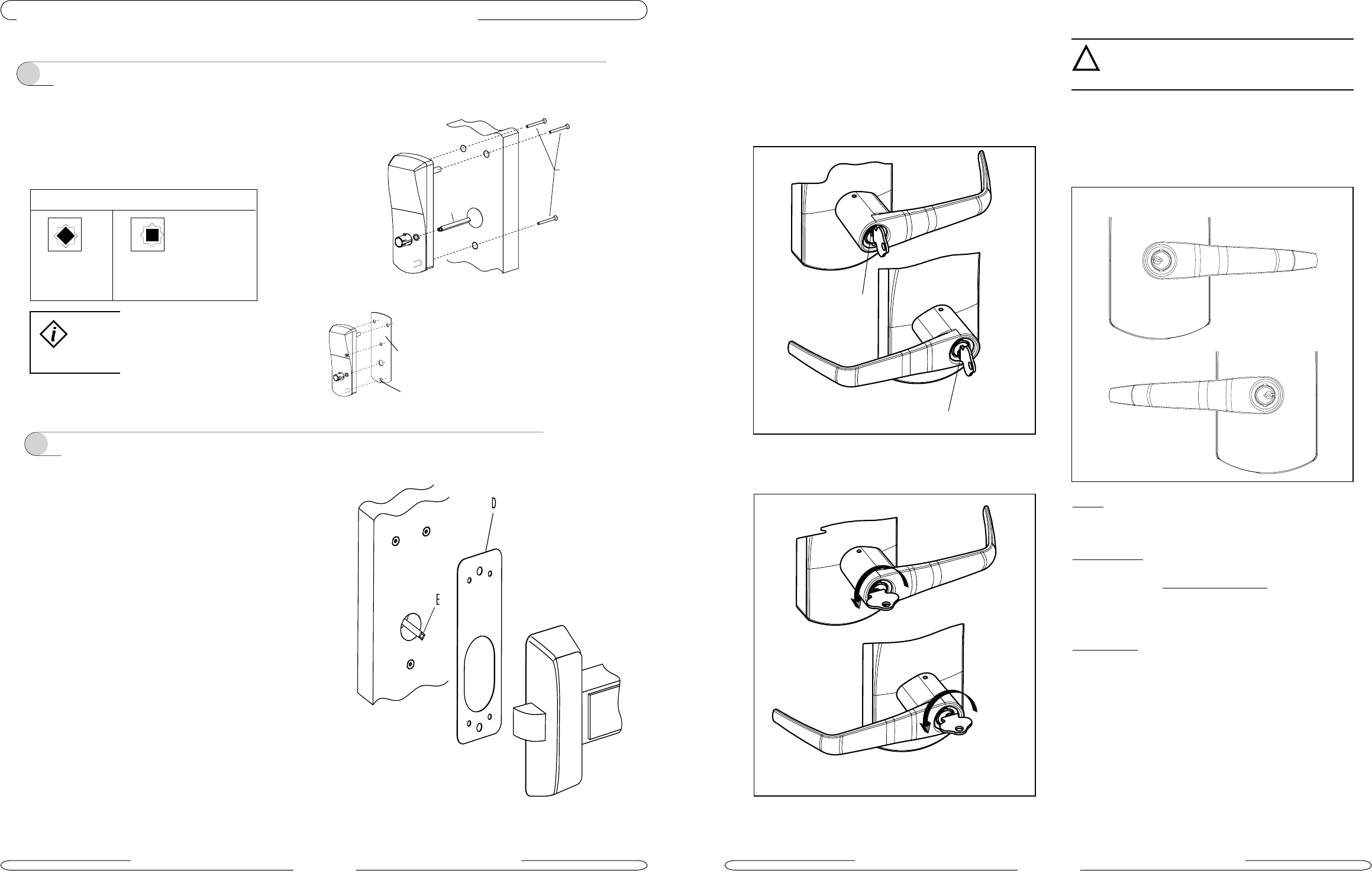
4 Install the Standard Exit Device and Strike
Follow the manufacturer’s instructions to install the exit device and an
appropriate strike. The Kaba dress plate is installed between the exit
device and the door to conceal the E-730/630/750/79E lock mounting
screws. Refer to page 3 for the part number and correct orientation of the
available dress plates.
Outdoor Gasket
Notch
E-730/630/750/79E SERIES INSTALLATION GUIDE • PK2925-T_11_07
Page 5
III INSTALL THE E-730/630/750/79E LOCK AND THE EXIT DEVICE
Install the gasket on the outside housing prior to
assembly, aligning the notch in the gasket with the
location of the battery compartment.
3 Install the Standard Exit Devices E-730/630/750/79E Outside Housing
Insert the slotted end of the spindle (K) into the outside lever hub until it
locks, at the correct angle for the exit device (see figure). The spindle can be
removed by pulling on it, and re-inserted if oriented incorrectly.
Place the outside housing on the door and fasten it using the three 10-24,
1
/8” hex head mounting screws (J).
Spindle Position
Yale Arrow
Precision
K
J
E-730/630/750/79E SERIES INSTALLATION GUIDE • PK2925-T_11_07
Page 14
Countersink in TOP Position
Countersink in BOTTOM Position
Hit the lever carefully with a rubber mallet to loosen the spring washer.
(you may want to cover the lever handle with a cloth or other material
to protect the finish of the metal)
9. Remove the key. The lock will look as shown in Fig.10.
Gently check the rotation of the lever handle. It should easily rotate
approximately 45º.
Troubleshooting:
Right-handed Lock: Turn the lever handle clockwise without forcing it. If
it stops at approximately 15º, it was not assembled correctly as shown
in step 4 (Fig. 6 & 7). Do not try to force it to turn. Release the lever
handle. Insert the small screwdriver (T, page 11) into the small hole on
the underside of the lever handle and push in the lever catch.
Re-do steps 2, 3, 4 & 5.
Left-handed Lock: Turn the lever handle counter-clockwise without forc-
ing. The drive hub (Fig.12 page15) should not rotate when the lever
handle is turned. If it does, it was not assembled correctly as shown in
step 4 (Fig. 6 & 7). Release the lever handle. Insert the small screw-
driver (T, page 11) into the small hole on the underside of the lever
handle and push in the lever catch. Re-do steps 2, 3, 4 & 5.
right-handed lock
left-handed lock
Fig. 10
!If it is not possible to turn the key counter-clockwise
to complete this step, the spring washer (D, see page 14)
may be too tense:
ATTACHING THE LEVER HANDLE TO THE LOCK
5.
7. Fit the lever handle onto the drive tube. It should rest approximately
1/16” from the body of the housing. (See Fig. 8)
If it can’t be pushed that close to the housing, the lever catch is
probably not pushed in. Push it in.
If the lever catch is stuck, the override shaft is in the wrong position.
The two small indents on the cross of the override shaft must be
vertically aligned as in fig. 2
8. Press the lever firmly against the housing while turning the key
counterclockwise (this applies to both right-handed and
left-handed locks) until it is in the horizontal position. (Fig. 9)
right-handed lock
left-handed lock
Fig. 8
Fig. 9
right-handed lock
left-handed lock
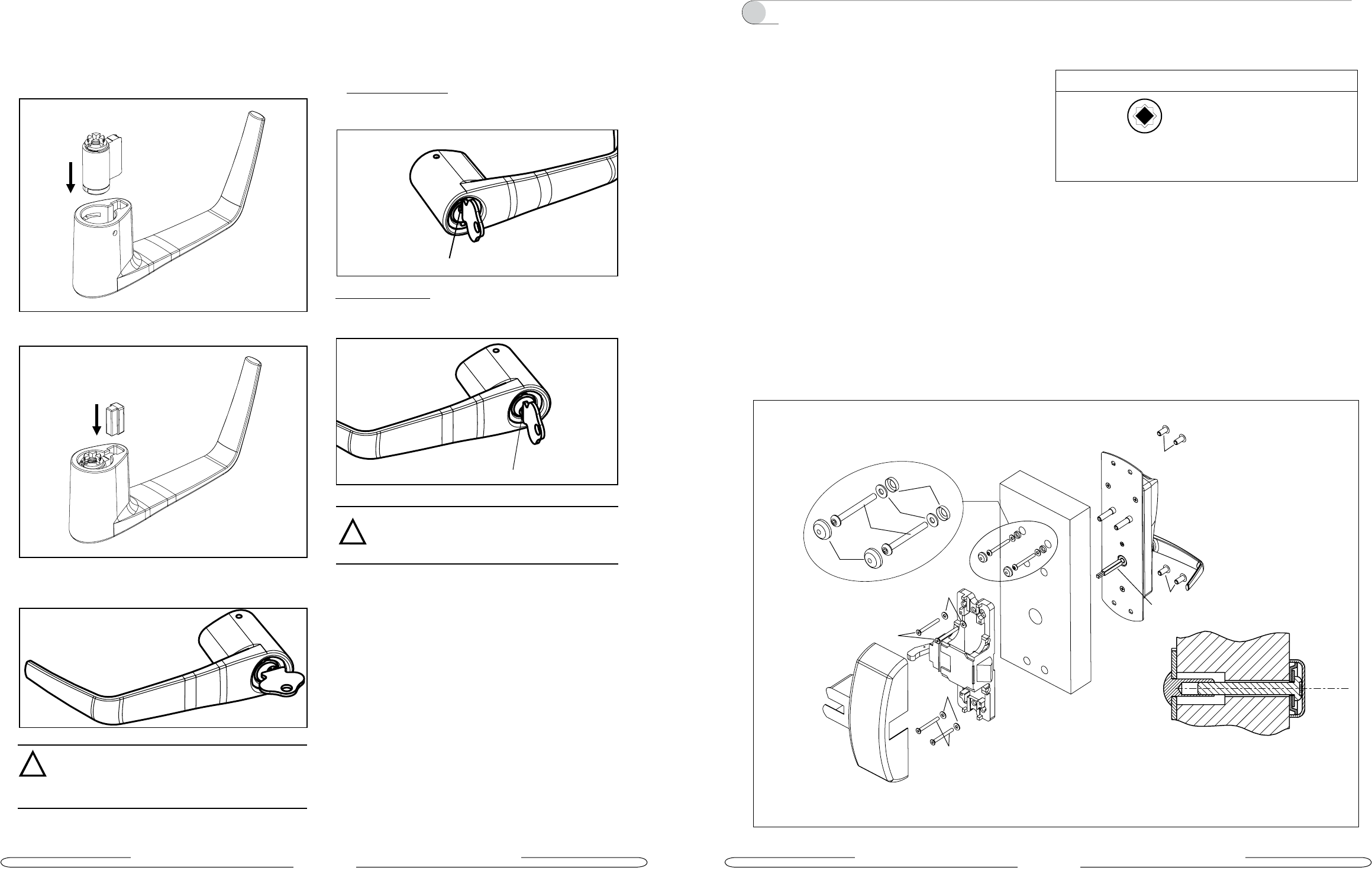
E-730/630/750/79E SERIES INSTALLATION GUIDE • PK2925-T_11_07
Page 13
3. Insert the cylinder into the lever handle (see Fig.3)
4. Put the cylinder plug into the lever (see Fig.4)
5. Making sure that the cylinder plug does not fall out, insert the key
into the cylinder. The key will be horizontal. (See Fig. 5).
Fig. 3
Fig. 5
Fig. 4
!
PREPARING THE LEVER HANDLE AND
CYLINDER FOR INSTALLATION
3.
6. Right-handed Lever handle: Turn the key aprroximately 90º to 100º
clockwise so that it is in the vertical position and the countersink is in
the top position. (See Fig. 6)
Left-handed lever handle: Turn the key approximately 90º to 100º
clockwise so that it is in the vertical position and the countersink is
in the bottom position. (See Fig. 7)
Troubleshooting:
If you have assembled the lever and housing with the key in the
wrong position, the key will get stuck. To remove the key, turn it so
that it is in the vertical position and insert a small flat screwdriver
Catch in (see page15 Fig.2). Remove key. If it is still stuck, turn the
in again with the small screwdriver. Remove key.
!
The key and the countersink must be in the positions shown
or the lever and the override mechanism will not work.
Fig. 6
countersink in the top position
Fig. 7
countersink in the bottom position
STEPS TO ATTACH THE LEVER HANDLE TO
THE LOCK HOUSING
*NOTE:
4.
E-730/630/750/79E SERIES INSTALLATION GUIDE • PK2925-T_11_07
Page 6
Mounting for:
and
4 Install the Outside Housing and the Precision 21/22/FL21/FL22;
Von Duprin 98/99EO-F/9827/9927 EO-F; ** Detex 10/F10/20/F20
Exit Device and Strike
Insert the slotted end of the spindle (E) into the outside lever hub until
it locks.
Ensure spindle is oriented as shown (Fig.A). The spindle can be removed
by pulling on it and re-inserted if oriented incorrectly. Place the Outside
Housing/Gasket/Adapter Plate Assembly on the door and secure this
assembly to the Exit Device Chassis by using 6 mounting screws (J,L,M).
First, fasten the mounting screws (J) into the posts of the Adapter Plate.
Next, insert 2 Mounting Plate Bushings (E) into the holes located at the
bottom of the Adapter Plate. For Detex Exit Device ONLY use 4 flat wash-
ers (W). Secure this section of the assembly to the Exit Device Chassis by
using the proper type of Mounting Screws (L).
Secure the top of the Adapter plate to the door by using the 2 Pan Head
Mounting Screws (M) and the Mounting Plate Bushings (E). To secure the
top portion of the Adapter plate, first pre-assemble the Pan Head Mounting
Screws (M) with the Washer (G) and then the Snap Screw Retainer (F).
Fasten the Pan Head Mounting Screws (M) to the Mounting Plate Bushing
(E), then install the Snap Screw Cap (H). Follow the manufacture’s instruc-
tion to complete the installation of exit device and the appropriate strike.
** Detex 10 & 20 Series are Panic Hardware only (Not Fire Rated)
Detex F10 & F20 Series are Fire Exit Hardware (Fire Rated)
Spindle Position
Fig. A
M
L
H
G
F
J
W
W
K
E
E
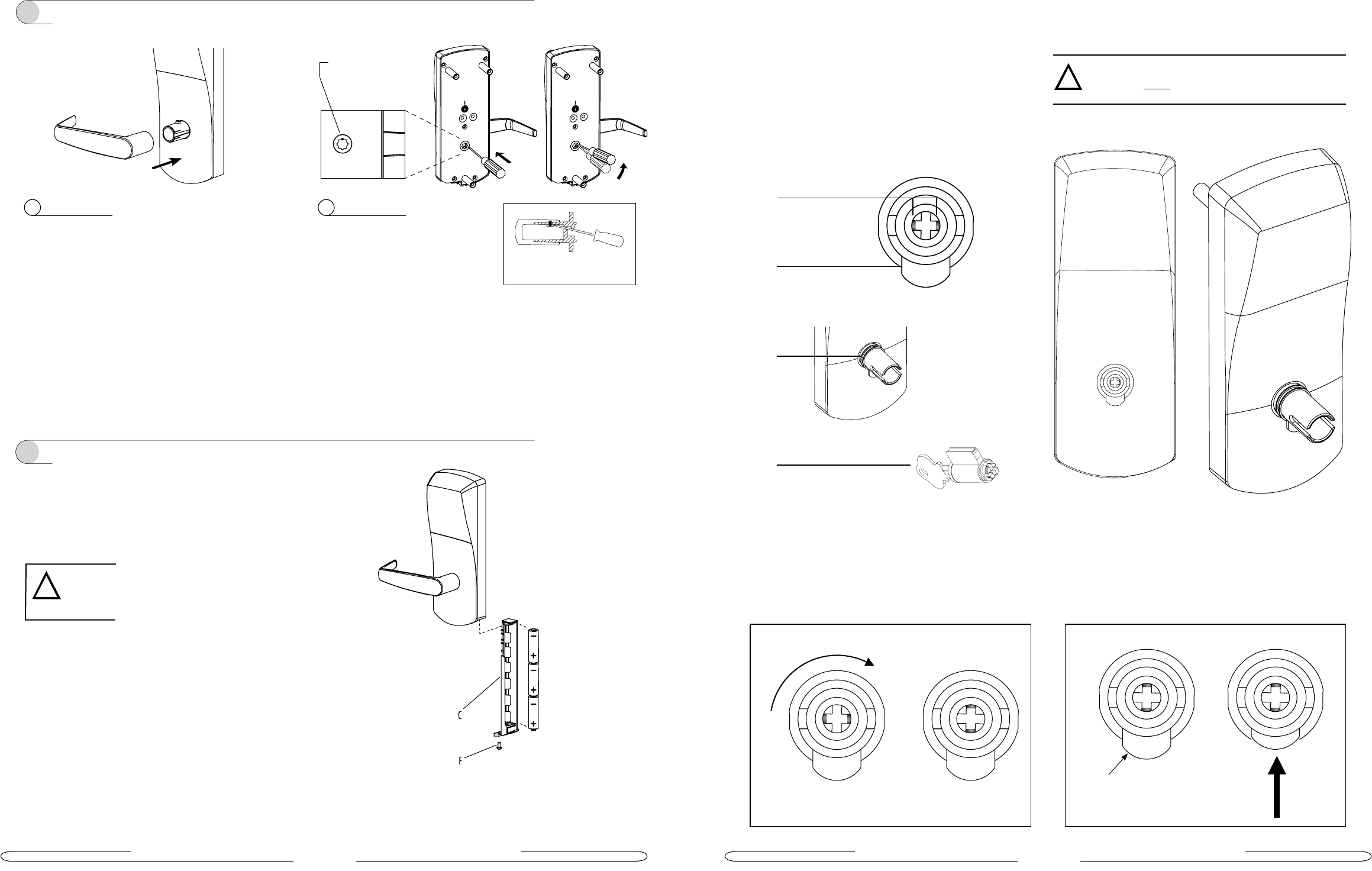
E-730/630/750/79E SERIES INSTALLATION GUIDE • PK2925-T_11_07
Page 7
Three AA batteries should already be installed in the battery holder (C).
Insert the battery holder into the outside housing and secure it using the
6-32 X 3/8” spanner drive screw (F).
* For Mechanical Override Models refer to page 11.
6 Install the Batteries
If the lock makes a continuous buzzing noise or the red
the battery holder for ten seconds, then reinsert it.
!
Assemble the lever on the outside housing, in the horizontal rest
position appropriate to the handing of the door as shown. Simply push
the lever onto the tube until it clicks in place. If more force is
required to engage the handle, use a rubber mallet. Test the attach-
ment of the handle by pulling smartly on it.
The lever is field reversible. If the handing is
incorrect, insert a small pick or flat screwdriver
in the hole in the hub as shown. Gently pry
back the spring clip inside the hub, and remove
the handle.
AB
5 Install the Outside Lever
Access Hole
cutaway view
E-730/630/750/79E SERIES INSTALLATION GUIDE • PK2925-T_11_07
Page 12
2. Push in the lever catch firmly. (see Fig. 2)
PREPARING THE OUTSIDE HOUSING FOR THE INSTALLATION OF THE LEVER HANDLE
1. Insert the cylinder(D) or equivalent tool into the override shaft and
turn it 90º clockwise so that the two small indents on the cross are
now vertically in line. (Fig.1)
(C)
(A)
(B)
(D)
Fig. 1 Fig. 2
lever catch
1.
2.
UPON UNPACKING, THE E-730/630/750/79E LOCK HOUSING WITH MECHANICAL OVERRIDE
SHOULD LOOK LIKE THE DIAGRAM BELOW WITH:
(A)
The small indents on the cross of the override shaft in line horizontally
(B) The nylon washer and the spring washer on the drive tube
(C) The lever catch in the out position
(D) Cylinder and 2 keys for 630 K/C included in the hardware bag
!Important: Assemble the lever, cylinder and lock
components before
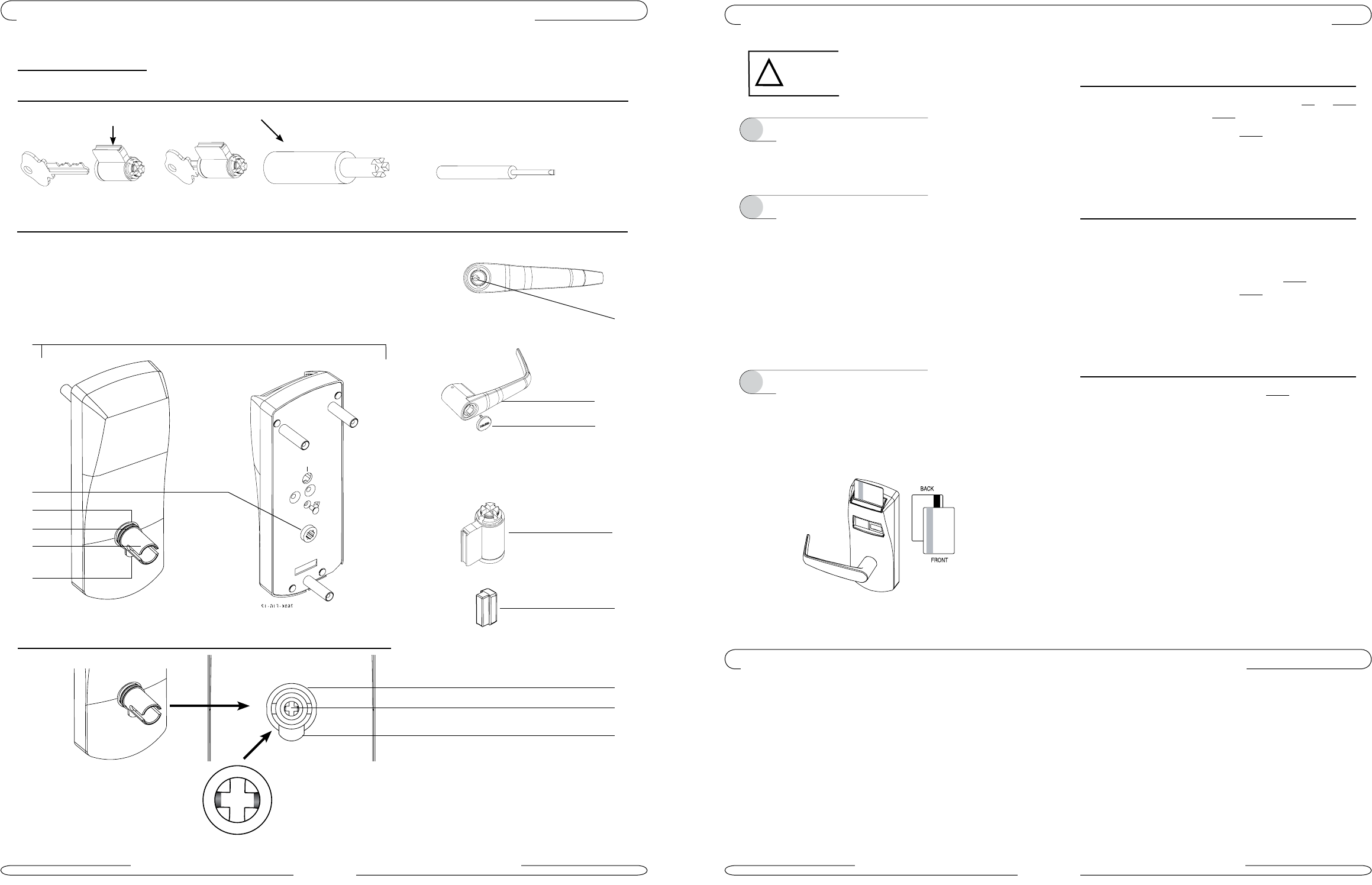
E-730/630/750/79E SERIES INSTALLATION GUIDE • PK2925-T_11_07
Page 11
VIII INSTALLATION OF THE MECHANICAL OVERRIDE ON 730/630/750/79E
Parts and Tools List
Tools Required:
(U) Cylinder (provided with lock) or equivalent (T) Small flat scewdriver (less that 1/8”)
(A) Lock housing
(B) Inside drive hub
(C) Nylon washer
(D) Spring washer
(E) Drive tube
(F) Lever catch
(G) Countersink
(H) Lever handle
(I) Cap
(J) Cylinder
(K) Cylinder plug
(L) Override shaft
Diagram of lock:
Facing view of drive tube: (E)
Back
(A)
(H)
(E)
(B)
(D)
(F)
(I)
(J)
(K)
(E)
(L)
(F)
(G)
(C)
E-730/630/750/79E SERIES INSTALLATION GUIDE • PK2925-T_11_07
Page 8
IV TEST THE OPERATION OF THE E-730/750/79E LOCK
Activate the panic bar. The latch bolt or rod retracts fully.
Turn the outside lever downward. The latch bolt or rod does not retract.
If the latch bolt or rod retracts, verify that the batteries are
properly installed.
If the lever feels tight (hard to turn, or does not return easily to its
horizontal rest position), check the spindle length vs. the door thickness
(the spindle may be too long). Check that the slotted end of the spindle
is inserted in the lock housing hub, not the exit device.
Test the lock’s response to keycards: a Test keycard, a Grand Master
keycard, and an Emergency keycard.
Insert keycards as shown below, with the magnetic stripe facing toward
the door and to the left. For 79E, present cards to reader.
1 Panic Bar
2 Outside Lever
A Test the Lock Before Programming
Normal Entry: Use the Test keycard with the reader. The red and green
LEDs each flash once and then the green LED flashes for four seconds.
Turn the outside lever downward while the green LED is flashing. The latch
or rod retracts fully. Release the lever, then turn it again. The latch or
first inserting the keycard.
B Lock Programming
Program the lock with its room number or Common Area number (exit
devices are usually programmed as common areas, see Reference
Manual).
Use the Grand Master keycard with the reader. The green LED flashes.
Turn the outside lever downward while the green LED is flashing. The latch
or rod retracts fully and the LED stops flashing after 4 seconds. Release the
lever, then turn it again. The latch or rod must not retract again
without first inserting the keycard.
C
Emergency Keycard Access
Use the Emergency keycard with the reader. The green LED flashes for 4
seconds. Then, turn the outside lever downward. The latch or rod
retracts fully.
While standing outside the room, close the door and ensure that it is
properly latched. Open the door using the Grand Master keycard using the
same procedure.
Caution! Perform the following procedures in order,
with the door OPEN unless otherwise indicated.
!
3 Electronics and Card Reader
V PROGRAM THE E-730/750/79E LOCK
Program the lock using the FDU and the E-730/750/79E communication cable (see Reference Manual). If this is not a new installation,
but a replacement of a single lock, or a group of locks in a property already equipped with the Solitaire system, transfer the security
information from a neighbouring lock to the new lock by using the Reset Addresses function (see Reference Manual).
In the case of a replacement lock, resetting the addresses will ensure that all past lost and stolen keycards
remain cancelled in the new lock, and will set the addresses for the Section, Floor, Group, Zone and Area sub-master level so that
staff keycards in use at the property will have the same pattern of access to the door as before. This step makes the lock replacement
transparent, so that the new lock accepts and rejects the same keycards as the old lock.
Front
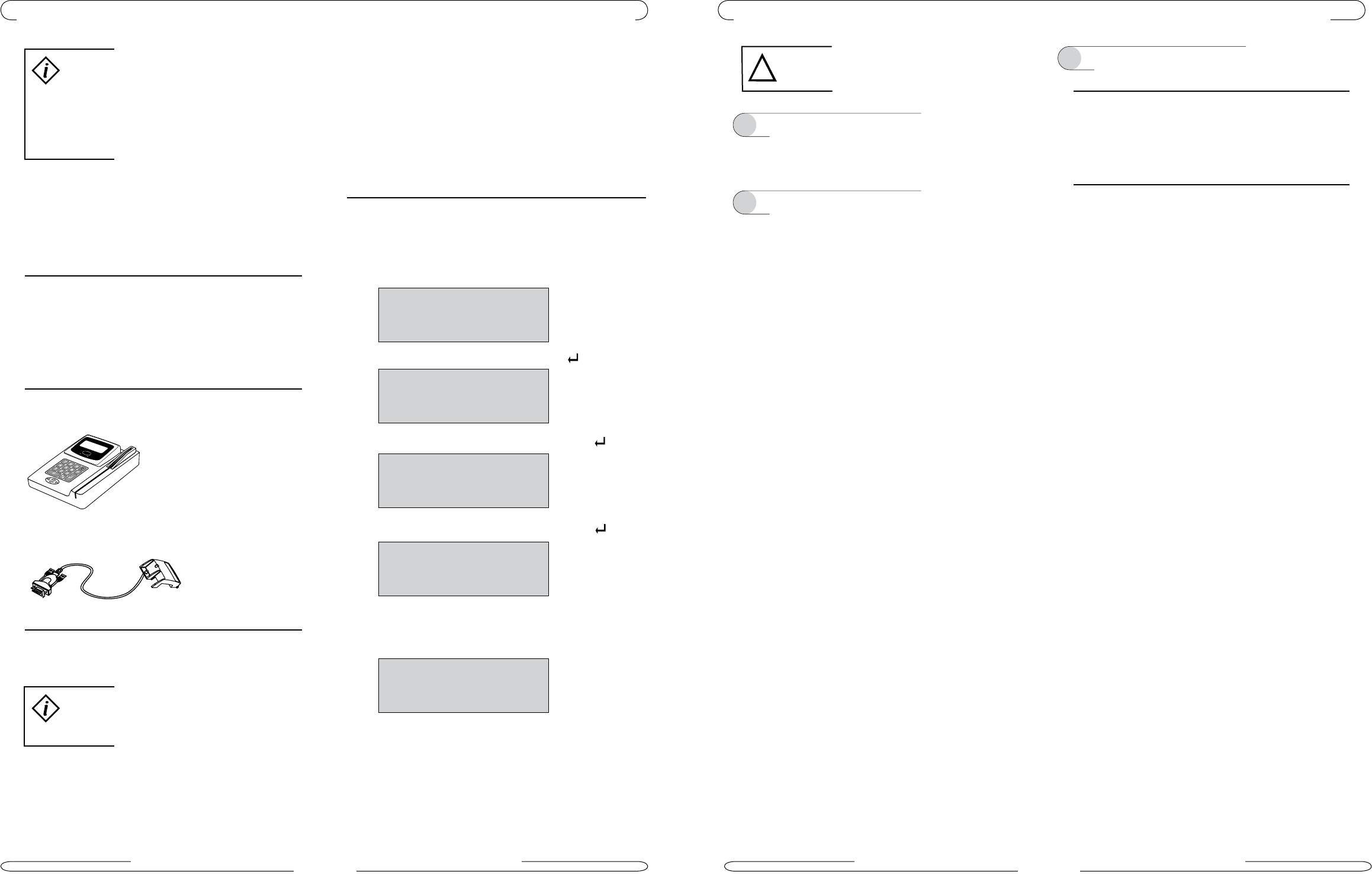
E-730/630/750/79E SERIES INSTALLATION GUIDE • PK2925-T_11_07
Page 9
VI OPERATING THE EMERGENCY OVERRIDE
If the card reader fails, the E-730/630/750/79E lock can be opened
using the FDU (Front Desk Unit). The lock must have been initialized by a
valid FDU from the hotel where it is installed (i.e. with the correct internal
and external hotel codes), before the electronic override can be used.
There are two possible security levels:
IF an FDU with a software version lower than 6.5
overrides the lock, the lock audit records only the date and time.
High security: IF an FDU with version 6.5 or higher software overrides
the lock, the lock audit records the FDU number, the Authorization keycard
number, the date and the time.
Hardware Required:
Minimum Authorization Keycard Required:
Programming Authorization (PA)
Steps to activate the E-730/630/750/79E electronic override:
1. Insert the communication cable into the lock. Wait 2 seconds, then
connect the cable to serial port A of the FDU.
2. Press any key to activate the FDU, then swipe a PA or higher keycard through
the FDU. If the green LED on the lock flashes once, disconnect the cable from
Serial Port A, wait 2 seconds, and reconnect the cable.
Main Menu:
1 = Keycard
2 = Reset
?
3. Enter 4 to select the Programming Menu, then press < >.
Program
1 = A lock
2 = Another FDU
?
4. Wait 2 seconds. Enter 1 to select the Lock option, and press < >.
Enter Function
1 = Program Addresses
2 = Reset Addresses
?
5. Enter 6 to select the Override/Reset Time option, then press < >.
Ready to Override
or Reset Time
Strike a key,
or C to quit.
6.
Wait 2 seconds, then press any key on the FDU to activate the electronic
override.
The green LED on the lock should light. The following message should appear
on the FDU screen immediately or within 2 seconds.
Communication Successful
Press any key to continue.
8. Open the door. You have only 4 seconds after this message
appears to open the door.
9. Remove the communication cable from the lock.
Some messages on the screen may differ
depending on the FDU version, but the menu
choices are the same.
Front Desk Unit (FDU)
FDU to Lock communication cable
If the lock will not respond to any keycard (including the Emergency keycard), there are three
options that should be attempted to open the door. In order, they are:
Initialization keycard in the lock, then use the Emergency keycard.
2. Use the electronic override feature (requires FDU and communication cable).
E-730/630/750/79E SERIES INSTALLATION GUIDE • PK2925-T_11_07
Page 10
VII TEST THE OPERATION OF THE 630 LOCK
Activate the panic bar. The latch bolt or rod retracts fully.
Turn the outside lever downward. The latch bolt or rod does not retract.
If the latch bolt or rod retracts, verify that the batteries are
properly installed.
If the lever feels tight (hard to turn, or does not return easily to its
horizontal rest position), check the spindle length vs. the door thickness
(the spindle may be too long). Check that the slotted end of the spindle
is inserted in the lock housing hub, not the exit device.
1 Panic Bar
2 Outside Lever
A Programming
Program the lock with at least one user, using the Oracode Maintenance
Unit. Generate a valid code for this user. (Recommendation: generate a
code that starts a day before today and finishes at least one day after
installation/testing date, in order to avoid check-in/check-out time
periods)
B Code entry and access
Enter the user code to validate complete lock operation. Verify that the
green LED flashes at each key pressed and a longer green LED flashes at
the end of the code entry. Turn the outside lever. Make sure the latch bolt
retracts fully. Release the lever, wait for the lock to return to the locked
mode (default settings is 5 seconds after unlocking), and then turn the
lever again. The latch bolt must not retract after the lock has
15 sec.) after unlocking, without first entering a valid user
code.
Caution! Perform the following procedures in order,
with the door OPEN unless otherwise indicated.
!3 Electronic
